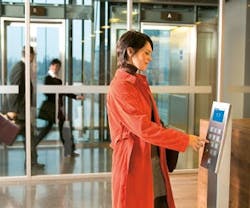‘Going Up’ is Made More Efficient
You probably don’t give the elevators in your building much thought, as long as they’re working like they should be. But recent advancements in elevator technology make things easier on building tenants and occupants – and easier on you.
New destination-based dispatching systems hitting the market have been shown to be far more efficient in terms of how building occupants are transported. These systems also provide significant increases in the number of passengers they hold at one time, and offer reductions in travel time.
How Do They Work?
Once a building occupant enters his or her specific destination floor into a touchscreen keyboard located in the elevator lobby, a nearby screen displays information to the occupant about which elevator he/she should board to get to the right floor. The occupant waits in front of the appropriate elevator with other people traveling to that floor (or a nearby floor), enters the elevator car once it arrives (with no need to push buttons inside the elevator), and travels with minimal stops to the final destination, explains Iain Kinner, KONE’s North American modernization product manager.
A Sense of Defense
If you think about the mechanical keys, cards, or PIN codes that have been used in elevators in the past, restriction of building access via the elevator isn’t a new concept.
The problem with these antiquated systems is that they can become expensive to manage. "Expensive re-keying may be necessary in the event that access control requirements change," says Kinner. Cards and PIN codes require individual management when user access requirements change and the system needs to be updated, he explains.
These methods do still have their place, however, and are appropriate in certain situations.
But destination-dispatch systems can provide your building with another layer of security. The destination call keypad itself can serve as low-level access control, requiring a PIN code from the occupant before certain floors can even be entered into the touchscreen keypad.
For additional security, you might think about linking a destination-based elevator system to turnstiles. "In such cases, a user will swipe his/her card at the security turnstile; the access control system will open the gate and, at the same time, generate a destination call request in the elevator system to the user’s ‘home’ floor," explains Kinner. Once the user goes through the turnstile, he/she just needs to check out the display located at the turnstile to find out which elevator to take.
Kinner points out, however, that integration of these elevator systems needs careful network consideration, with a specific network dedicated specifically for access control. "Normal office networks should not be acceptable because of the security risks," he says. He recommends a fast network (a minimum Ethernet speed of 100 Mbits/s), as well as careful consideration of the network load generated by other applications.
Elevator Maintenance
Destination-based dispatching systems offer one central management location where you can make updates across the building. "The simplest interface between systems would be for the building security management system to provide a set of ‘dry,’ voltage-free contacts to feed information about floor access permissions to the elevator system. Data transmission between systems has historically been more complex, although standard protocols are now becoming more established for a transparent interface of defined data between systems," says Kinner. B
Leah B. Garris ([email protected]) is managing editor for BUILDINGS magazine.
